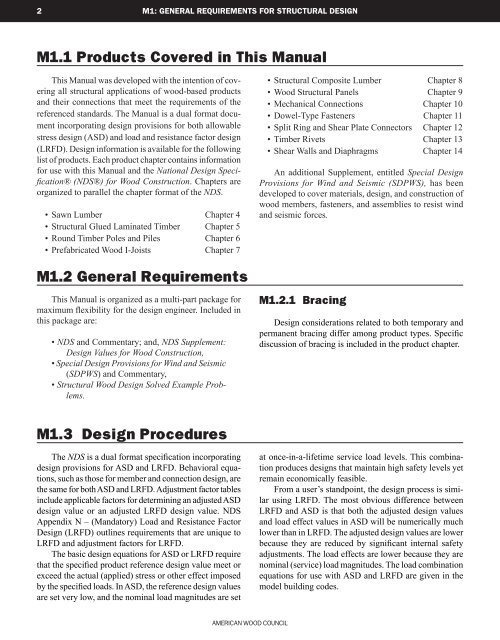ASD/LRFD Manual - American Wood Council
ASD/LRFD Manual - American Wood Council
ASD/LRFD Manual - American Wood Council
You also want an ePaper? Increase the reach of your titles
YUMPU automatically turns print PDFs into web optimized ePapers that Google loves.
M1: general requirements for structural design<br />
M1.1 Products Covered in This <strong>Manual</strong><br />
This <strong>Manual</strong> was developed with the intention of covering<br />
all structural applications of wood-based products<br />
and their connections that meet the requirements of the<br />
referenced standards. The <strong>Manual</strong> is a dual format document<br />
incorporating design provisions for both allowable<br />
stress design (<strong>ASD</strong>) and load and resistance factor design<br />
(<strong>LRFD</strong>). Design information is available for the following<br />
list of products. Each product chapter contains information<br />
for use with this <strong>Manual</strong> and the National Design Specification®<br />
(NDS®) for <strong>Wood</strong> Construction. Chapters are<br />
organized to parallel the chapter format of the NDS.<br />
• Sawn Lumber Chapter 4<br />
• Structural Glued Laminated Timber Chapter 5<br />
• Round Timber Poles and Piles Chapter 6<br />
• Prefabricated <strong>Wood</strong> I-Joists Chapter 7<br />
• Structural Composite Lumber Chapter 8<br />
• <strong>Wood</strong> Structural Panels Chapter 9<br />
• Mechanical Connections Chapter 10<br />
• Dowel-Type Fasteners Chapter 11<br />
• Split Ring and Shear Plate Connectors Chapter 12<br />
• Timber Rivets Chapter 13<br />
• Shear Walls and Diaphragms Chapter 14<br />
An additional Supplement, entitled Special Design<br />
Provisions for Wind and Seismic (SDPWS), has been<br />
developed to cover materials, design, and construction of<br />
wood members, fasteners, and assemblies to resist wind<br />
and seismic forces.<br />
M1.2 General Requirements<br />
This <strong>Manual</strong> is organized as a multi-part package for<br />
maximum flexibility for the design engineer. Included in<br />
this package are:<br />
• NDS and Commentary; and, NDS Supplement:<br />
Design Values for <strong>Wood</strong> Construction,<br />
• Special Design Provisions for Wind and Seismic<br />
(SDPWS) and Commentary,<br />
• Structural <strong>Wood</strong> Design Solved Example Problems.<br />
M1.2.1 Bracing<br />
Design considerations related to both temporary and<br />
permanent bracing differ among product types. Specific<br />
discussion of bracing is included in the product chapter.<br />
M1.3 Design Procedures<br />
The NDS is a dual format specification incorporating<br />
design provisions for <strong>ASD</strong> and <strong>LRFD</strong>. Behavioral equations,<br />
such as those for member and connection design, are<br />
the same for both <strong>ASD</strong> and <strong>LRFD</strong>. Adjustment factor tables<br />
include applicable factors for determining an adjusted <strong>ASD</strong><br />
design value or an adjusted <strong>LRFD</strong> design value. NDS<br />
Appendix N – (Mandatory) Load and Resistance Factor<br />
Design (<strong>LRFD</strong>) outlines requirements that are unique to<br />
<strong>LRFD</strong> and adjustment factors for <strong>LRFD</strong>.<br />
The basic design equations for <strong>ASD</strong> or <strong>LRFD</strong> require<br />
that the specified product reference design value meet or<br />
exceed the actual (applied) stress or other effect imposed<br />
by the specified loads. In <strong>ASD</strong>, the reference design values<br />
are set very low, and the nominal load magnitudes are set<br />
at once-in-a-lifetime service load levels. This combination<br />
produces designs that maintain high safety levels yet<br />
remain economically feasible.<br />
From a user’s standpoint, the design process is similar<br />
using <strong>LRFD</strong>. The most obvious difference between<br />
<strong>LRFD</strong> and <strong>ASD</strong> is that both the adjusted design values<br />
and load effect values in <strong>ASD</strong> will be numerically much<br />
lower than in <strong>LRFD</strong>. The adjusted design values are lower<br />
because they are reduced by significant internal safety<br />
adjustments. The load effects are lower because they are<br />
nominal (service) load magnitudes. The load combination<br />
equations for use with <strong>ASD</strong> and <strong>LRFD</strong> are given in the<br />
model building codes.<br />
<strong>American</strong> <strong>Wood</strong> <strong>Council</strong>

















